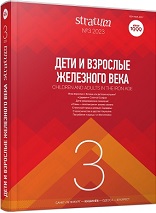Ажурные бляхи IV—II вв. до н. э. из памятников Центрального Предкавказья
Openwork Plaques of the 4th—2nd Centuries BC from the Sites of the Central Ciscaucasia
Author(s): Yuriy A. ProkopenkoSubject(s): History, Archaeology
Published by: Издательский дом Stratum, Университет «Высшая антропологическая школа»
Keywords: Central Ciscaucasia; openwork plaques; typology; umbonoid protrusion; spoke rays; pearl decor; slotted triangles; segmental cutout; corrugation
Summary/Abstract: The article examines the typological features of bridle openwork plaques found in 4th—2nd centuries BC sites in the Central Ciscaucasia. The majority of the objects were found in hoards of items of horse harness, jewelry and amulets: in Stavropol and near Mount Zmeika. In isolated cases, they are recorded in burials of the 3rd—1st centuries BC (Samashkinsky III burial ground, mound 3, burial no. 19; Nizhne-Chereksky mound, burial 5). The 25 found specimens conventionally belong to five types. Type I — wheel-shaped — 10 copies; type II — star — 2 copies; type III — pearl — 7 copies; type IV — lattice — 1 copy; type V — corrugated — 5 copies. Analogies to these plaques are recorded in the sites of the Southern Urals, Middle Don, Kuban, Dagestan, as well as in earlier sites of the Koban culture (Central Ciscaucasia). The peculiarities of the types of bridle balls originating from the 4th—2nd centuries BC sites in the Central Ciscaucasia reflected the influence of local traditions of the Koban decorative and applied art and the general fashion for decorating items of horse harness typical for the nomadic culture of the steppe population.
Journal: Stratum plus. Археология и культурная антропология
- Issue Year: 2023
- Issue No: 3
- Page Range: 121-132
- Page Count: 12
- Language: Russian
- Content File-PDF

